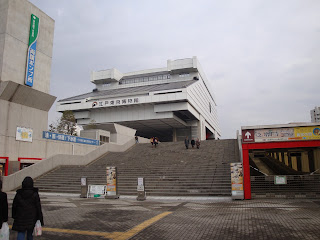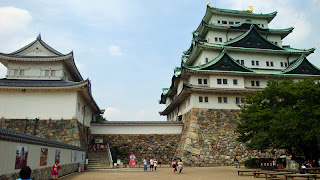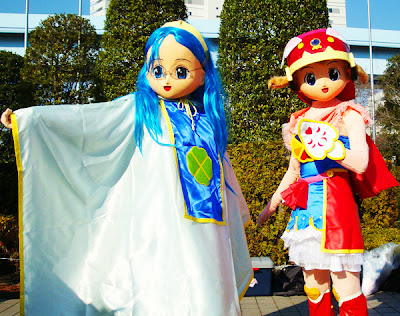Kagura is a form of ritual dance that has existed in multiple forms in Japan since ancient times. It is actually from these folk kagura dances that Japan's oldest form of theater, Noh, originates. In northeaster Tohoku many forms of kagura exists, but the form that usually stands out the most are those that involve a divine deer for the dancers wear elaborate masks and typically have two long antlers protruding from their backs. The pictures show are of the more southern version of the deer kami costume. The further North one goes the larger the costume and the antlers become. This particular dance photographed was in Sendai for a festival celebrating a previous feudal lord. Notice the feudal markings on the costume. Of interest is how much of the dance revolves in a circular motion consistent with circling a fire common in old shamanic rituals. The addition of a tree common to tanabata celebrations was interesting since this was not a tanabata related celebration. Sendai already bosts the largest tanabata festival in the nation which was not overlapping with the event depicted. Although the costumes are less elaborate than those found further north, the mouths of these costumes opened whenever the dancer leaped into the air.
This is blog is a student assignment for a university visual anthropology course. The blog shall be terminated upon the end of the course in April 2012. Permission has been obtained from individuals before the posting any images of persons. In the case of more general images, great consideration has been given to individual privacy and respect in these circumstances. However, should there be any concerns please contact me and I shall move to quickly resolve them including image removal.
Thursday, April 5, 2012
Oni Everywhere
Although it wouldn't be too odd to see a depiction of the Christian devil at Halloween, on a brand of alcohol, or a spicy hot sauce in the United States, you certainly won't find giant devil heads or demon displays at the local grocery store or 7Eleven. Were such a display as the one above be put in a US grocery store Christian groups would quickly condemn the store and protest. In Japan however Oni can be found on most anything. Although usually depicted as being red and possessing horns, oni are more ogres than anything demonic in the Christian sense and their use in imagery and folklore has changed over time. While once feared ogres with large clubs that attacked villages or travelers, it is not unusual to see an oni lead a parade to ward off evil spirits today. Oni are also often depicted as being comical in that they are not always very bright. Even "cute" versions can be found on various store products. Although the traditional side sometimes comes out as is the case in early February when dried beans are thrown about in parades, shrines, and although not much any more a person's home. Guides on how to through the beans and locate the correct direction to ward off Oni were posted in my local grocery store. I bought some of the beans, but got hungry before going to a temple and ate them. Tasty.
Sakura
A visual blog about Japan without some hanami, sakura blossom viewing, seems like a sin. So in Aomori's splendor, here are some photos of the Hirosaki Castle sakura trees. I've noticed that the trees actually seem to have more blossoms on them in Aomori than when I've gone in Tokyo, but this may very likely be bad luck on my part. Tokyo seems to have worse wind during sakura season than Aomori. This past Tuesday I'm sure wreaked havoc on sakura viewing season with the typhoon that passed by. Whatever blooms had opened likely blew away that day. This might explain why people from all over the country make their way to Hirosaki in Aomori for the cherry blossom festival there. That and it last later into the spring since the weather does not warm up as fast as it does further south. I've heard it described as the "sakura's march north" to refer to how the country comes into bloom as the heatwave moves north over March and April. But be warned, Hirsosaki castle has a moat so be prepared to be ordered into a rowboat to taxi around any romantics you may be visiting with through the sakura petal covered water.
Tengu
Tengu are an ambivalent supernatural being or sometimes monster that can be found throughout Japanese folklore and have any number of different manifestations depending upon the region visited. I've mostly run into depictions of tengu in areas that possess many hills or mountains. I don't think I've ever encountered an area that openly features tengu folklore outside those geographical areas. I actually don't know much about tengu yet, but it seems tengu are sometimes used in the same roles oni are used in other regions, even the same festivals. While I've encountered small shrines that are supposed to keep a tengu imprisoned on a mountain, I've seen people dressed as tengu leading parades that had nothing to do with the tengu themselves. Interesting to see how the same or similar supernatural being is treated in varying areas.
Aesthetics of simplicity?
I sometimes have to wonder about just how traditional simple aesthetics is in Japan. For all of the simple aesthetics found in old temples, Japan sure seems to like large extravagant buildings. A visit to Odaiba or Shinjuku quickly yields large buildings of complicated, if not futuristic appearing designs. Even areas with a traditional flare often are very extravagant in their own right by providing a sensory overload of symblism. A desire for the large and untouchable also goes back hundreds of years. Nagoya and Osaka castle are anything, but quaint structures. Powerful temples in the past were also made very large, requiring full tree trunks from overseas to sometimes be importeted to make the temple larger than it otherwise would be able to be. Size and power seems to have existed for a long time, so perhaps some simplicitiy was due to economic reasons and then romanticized later rather than pure aesthetic value.
Umbrella Vending Machine
Although I am usually not a fan of focusing on "only in Japan" sort of things, but the umbrella vending machine was just too difficult to ignore. Anyone who comes to Japan is aware of the relationship shared by the Japanese and vending machines. Just about anything can be found in one, to include umbrellas. While strikingly odd to an American, such a vending machine actually makes a lot of practical sense in Japan. The machine pictured above was located in a hotel lobby in a urban area. In large Japanese cities, walking is often the primary means of transportation along with trains and buses, which still require the individual to walk before and after getting on board public transit. So a sudden change in the weather forecast can make a large impact on a person's day so a convientently located umbrella vending machine is actually very practicle.
Wednesday, February 22, 2012
"Kigurumi" as a hobby
Kigurumi (着ぐるみ) is a term for masked full body costuming in Japan. Costumes range from animals to "giant" robots to cartoon characters. Most people are familiar with kigurumi through performers at major theme parks such as a full Mickey Mouse costume at Disney World. In Japan there are hobbyists who perform kigurumi for fun at costuming and related events such as Wonder Festival in Chiba. Held twice a year, Wonder Festival is Japan's largest amateur figurine & sculpting convention. With the focus of the event being on amateur craftsmanship, costuming has become a growing side feature of the convention. Animegao (アニメ顔), literally animation face, is a subset of kigurumi where full body costumes of Japanese animation and game characters are worn, although the term animegao is not preferred by the performers themselves. Note performer is used, not costumer. This is because, like the Mickey Mouse performer at Disney World, amateur performers dressed as anime characters never speak when in costume and act the part of their character through exaggerated body movements when engaged by a spectator. Most costumes are of female characters and the majority of people involved in the hobby are men. But I saw two kigurumi costumers with their masks off who were women while at Wonder Festival. Those men who I have talked to, despite wearing female costumes, are heterosexual and don't see the wearing of the mask as a way of cross dressing while remaining anonymous. This is very believable since more men openly dressed as female characters without a mask than there were those in kigurumi. The kigurumi hobbyists viewed the costumes as being as authentic to a figurine or character as a costume can be and enjoy the performance side of it since as a man, they can bring out the desired feminine attributes of the character in only the way a male can much like a Kabuki actor.
Izanagi Okami shrine in Ryogoku
The deity Izanagi has been worshiped since at least the beginning of the 8th Century C.E. and gained popularity during the Edo Period. Izanagi is a deity of fertility, rice, agriculture in general, blacksmiths, industry, and foxes and can be portrayed as a man, woman, or androgynous suggesting that the Izanagi may be a combination of several deities. Izanagi has remained in favor in modern Japan by having a connection with business and industry. Izanagi shrines are typically easy to identify since images of foxes are usually present. These kitsune are messengers of Izanagi. This positive representation of foxes intrigues me since many rural superstitions exist, particularly in northern regions, portraying foxes as mischievous supernatural creatures that cause all any number of problems including possession. Even up until the 20th century families that had been labeled "fox owning" families were persecuted by their villages.
Thursday, February 9, 2012
China Town
Sumo Introductions, Music?
The introductions caught my eye because they are rather musical in nature. The tones and general rhythm of each introduction follow a precise patern, but small variations can be heard amongst each individual. Most examples of traditional Japanese music place focus on the voice as the primary instrument and this often extends to forms of narration such as the Tayu of Bunraku plays, so it is not too surprising to find the voice used in such a musical manner.
Subscribe to:
Posts (Atom)































